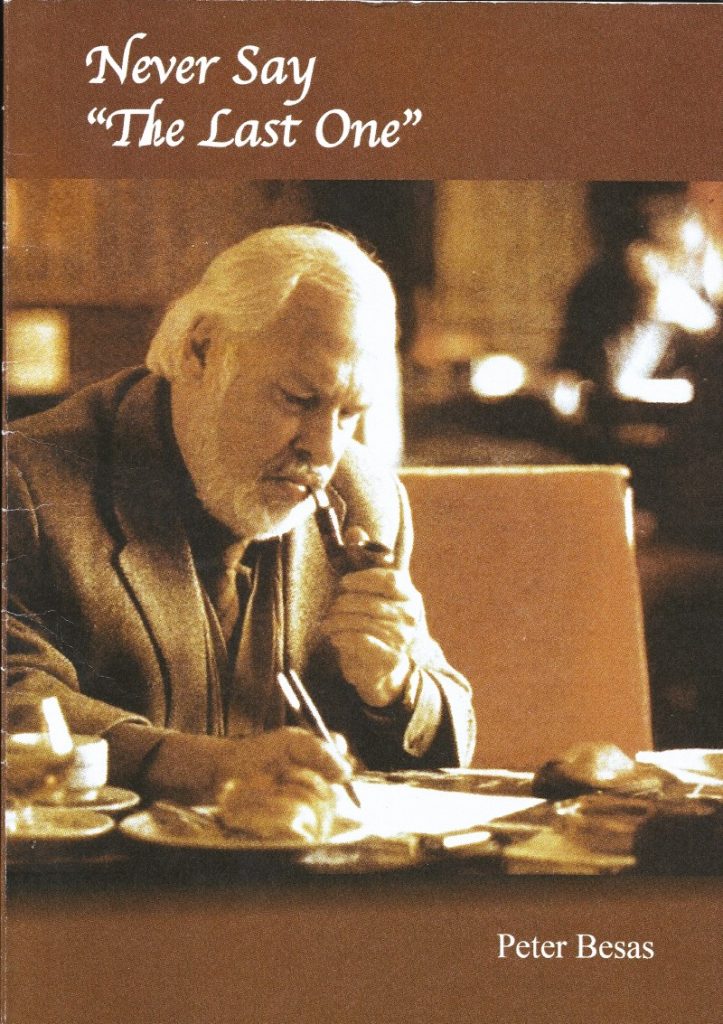By Robert Marich
While many muggs hang up their Underwoods with retirement, our Peter Besas celebrated his 90th birthday in Madrid with a self-printed booklet “Never Say, ‘The Last One.’” Besas (sig “Besa”) served as Madrid stringer and later bureau chief and Latin American Director of Operations for Variety from 1969 to 1999.

After leaving the paper, he created a cottage industry as an author, writing Spanish and English-language books, the most commercially successful being an offbeat guide to the Spanish capital that he wrote with his son Mark called “Hidden Madrid”. There followed two additional “Hidden Madrids”, and a “Special Edition”. The book is now in its 11th Spanish edition and 5th English edition, and still going strong at the bookshops.
Then followed books such as “Nazis in Madrid” in both Spanish and English editions, a book that ties together geographic locations and events providing the history of the intrigues that unfolded as the Allies successfully kept Franco-led fascist Spain neutral during World War II. He also authored a work on antiquarian bookshops in Madrid, another on 19th century inns in the Spanish capital and a semi-autobiographical book on the Yank expat community in Madrid during the Franco era (from 1959 to 1975) called “A Yank in Franco Madrid”.
Besas’ books are noteworthy for their high-quality printing, and design, which is evident from the weight and sturdiness when holding them.
In fact, thanks to an arrangement with his Madrid publisher, he designs and does the layout of the books on his own, including selection and placing of illustrations, type face and size, cover and back cover design and other details that make each book physically attractive.
His recent little effort, printed for his friends to celebrate his 90th, “Never Say ‘The Last One” is highly personal. The title refers to a Spanish custom: When friends gather in a bar and one is about to toast the “final” drink, his or her companions inevitably will quip, “Never say ‘The last’”. It must always be the “next to last” drink. (In Spanish, la penúltima copa.)
In the booklet Besas quotes Cicero on old age; details his life in economy class restaurants on two continents; laments that most of his favorite haunts have closed or went unrecognizably trendy; celebrates the unhurried boulevard lifestyle at cafes in the European tradition; and also rejoices in being a bibliophile
“Doubtless, one of the advantages of full maturity is that the older you get, the fewer are the threats that hold any power to frighten you,” writes the 90-year-old Besas. “They can’t fire you from your job. You need not worry about getting rich since either you’ve made your bundle or you have not. [And] no worry about making new friends—the old ones are the best.”
At another juncture, he writes: “Over the past decade or two, a slew of high-priced fancy restaurants have flooded Madrid serving nouvelle cuisine, meaning fancy gastronomical inventions whose ingredients are sometimes unrecognizable… Gone are the simple desserts, such as fresh fruit, rice pudding and custard, which are now replaced by gooey cheese cake or calorie-heavy cakes.”
His literary career also includes scribing a definitive historical book “Inside Variety” that was published in 2000 and was well-reviewed at the time, including a full-page review in the literary supplement of the Los Angeles Times. The book was then launched at a cocktail reception at the iconic now-defunct Gotham Book Mart in Midtown, with a dozen of the muggs, including Syd Silverman, attending.
“Inside Variety” lovingly and painstakingly records the history of Variety under the founding Silverman family, tracing its development from a 1905 live entertainment sheet; it traces its idiosyncratic “slanguage”, the struggles of its founder, Sime Silverman, against competitors, and its fame as the “bible of Show Business”. The 563-page hardcover book includes taped interviews with 38 ex-muggs who worked on the paper.
It illuminates the quirky employees that thrived in Variety’s decidedly un-corporate atmosphere in a brownstone on West 46th Street up to the time it was sold in 1987 to a corporation. Besas is an example of one of those idiosyncratic characters, since his own life story is out-of-the-ordinary.
Besas was born in Berlin in 1933, but his parents had to flee from the Nazis (his father was Jewish), finally arriving in New York in April 1940 on the last ship to leave Oslo before it was invaded by the Germans. He grew up in Washington Heights, was schooled at Stuyvesant High School and City College and moved to Madrid with his Spanish wife, now passed, in 1965. Besides his work in journalism, he has worked as translator, radio broadcaster, travel guide revisor, and editor of various magazines.
Other muggs from the editorial side quit the wordsmith racket after leaving Variety. But Besas keeps remembering, chronicling and writing. His latest book, “Stagecoach to Madrid”, a history of diligence travel in 19th century Spain, is due to be published in Madrid in both English and Spanish editions later this year.
end
